yeovil people
peter daniell
Draper and Town Developer
Peter Daniell was born in 1764 the only son of wealthy glover, William Daniell. Peter's great-grandfather was Samuel Daniell II, who was also the great-grandfather of John Daniell Jnr. In 1778 Peter leased the Church House, on the site of the later London House. This was on the corner of Middle Street and Silver Street, facing the Borough, which Daniel Vickery described as "a kitchen and little room within the same, a large chamber over, a cellar, a yard, the great chamber facing the Borough and market house, with a garret or cock-loft over, and three chambers within the said chamber."
William Daniell died in 1779 and Peter inherited his father's large property called The Mansion House that had been built in Middle Street on the site is now occupied by WH Smith's bookshop. Preferring to live in his own Penn House, Peter Daniell let out his father's house and the notice in the Bath Chronicle below clearly details the property and the first map below clearly shows the extensive land holdings associated with the property.
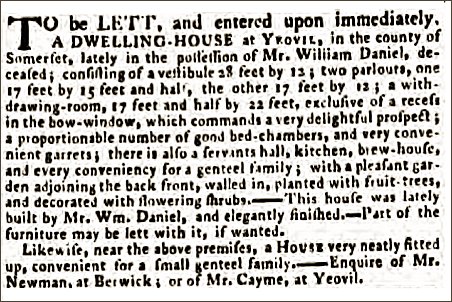
Bath Chronicle &
Weekly Gazette,
29 July 1779
In a deed of 1784 Peter was referred to as a 'Draper and Mercer' and in 1793 he was listed in the Register of Duties Paid for Apprentices' Indentures. He was listed as a grocer of Yeovil and the apprentice was Edmund Cheeves. A similar entry of 1800 listed Daniell as Draper etc. and the apprentice was John Cayme. He was listed as a linen and woollen Draper in 1805 but in deeds of 1806, 1808 and 1809 he was referred to simply as a Merchant.
In April 1798 he was married to Anne Hansford, second daughter of Captain Hansford RN, and they had three sons; William Hansford (1798-1823), Henry Peter (baptised 22 May 1802, later Reverend Henry Peter Daniell) born 1802, and Edward Hansford (b1804 and also later in holy orders). Only Henry and Edward are mentioned in their father's will dated 1828 (see below) since solicitor William (of Middle Temple) died of fever, aged 24, on 28 October 1823 while travelling in Italy.
At the beginning of the nineteenth century it was expected that Napoleon would invade England. To counter this, as across the country, a volunteer infantry Regiment was raised and the Yeovil sub-division consisted of eight companies each of 60 privates. Initially this was commanded by Colonel the Hon. Thomas Fane of Brympton but he was succeeded in 1806 by Major, Peter Daniell.
In 1785 he was noted as a subscriber to 'The Life of Jacob in Ten Books' by M Peddle. In 1809 the Yeovil Book Society was formed and Peter Daniell was a prominent member. It was an exclusive society limited to just 20 members, each of whom paid half a guinea entrance fee and an annual subscription of £1. In 1814 he subscribed to 'An Historical View of the State of the Protestant Dissenters in England, And of the Progress of Free Enquiry and Religious Liberty, from the Revolution to the Accession of Queen Anne' by Joshua Toulmin.
In the 1810's, with unrest caused by the enclosure of common land, low wages and ever increasing prices, civil unrest was becoming more frequent across the country. In 1813 a Yeovil Association was formed in order to provide legal aid to property owners seeking redress for loss or injury caused through civil disturbance. Twenty persons insured themselves, for an annual subscription of half a guinea, one of whom was Peter Daniell. By 1829 the Association had thirty three additional members.
Peter Daniell had been in partnership with Lewis Beacham as drapers. The partnership was dissolved on 26 February 1821 and the company was to continue as Daniell & Company.
By 1825 St John's churchyard was becoming full. Although the idea of constructing catacombs on the western side of the churchyard, facing silver Street, had been discussed by the Vestry, the Bishop vetoed the idea of catacombs. As a consequence Peter Daniell sold a piece of land between the churchyard and North Lane, and between North Lane House to the west and Church Terrace to the east, for £525 so that the churchyard could be extended. The Churchwardens' Accounts for 1825 record "At a Vestry duly convened for taking into consideration the expediency of enlarging and inclosing the Church Yard in pursuance of the Directions of the Lord Bishop of the Diocese, held this nineteenth day of September 1825 It was unanimously resolved - That it is expedient to enlarge the Church Yard: - That the offer now made, on the behalf of Mr Daniell to sell to the Parish the Cottages and gardens within the Paling which divides the land in the possession of Mr Mitchell (North Lane House?) from the said Garden for £525 be acceded to."
In 1829 the Land Tax Returns noted Peter Daniell as owning The Mansion House in Princes Street, where he lived prior to moving to Penn House, as well as a shop in Middle Street (the Church House), two houses in the newly constructed Bond Street, three tenements in South Street and Hollands House. He was one of the first Town Commissioners in 1830 (although he never attended a single meeting) and also in this year he financed the building of the house known as Grovecote in Preston Road as the manse for the minister of Yeovil's Unitarian Chapel in Vicarage Street on ground previously given to the society.
Peter Daniell inherited a large area of land (see map below) between Middle Street to the north, South Street to the south and Wine Street to the west (see map below), as well as his father's large property in Middle Street, called The Mansion House. He became a town developer and around 1830 built Bond Street and Union Street on his land to connect Middle Street with South Street. Cutting between Bond Street and Union Street he built Peter Street which he named after himself. He also built Park Street, Belmont and Brunswick Street between 1825 and 1834, which skirted his land at Penn Hill.
In the "Registry of Deaths of Persons Connected with the Unitarian Congregation, Yeovil" on page 33 is noted "1834. Peter Daniell of Yeovil late Linen Draper etc. died 9th August. Buried in the Parish Church." He was aged 73. According to the Sherborne Mercury, he died "at his residence in Yeovil" and was noted as "one of the oldest inhabitants of the town." A memorial was erected to his memory in St John's church. Anne died on 20 December 1848 at Yeovil, aged 83.
MAPs
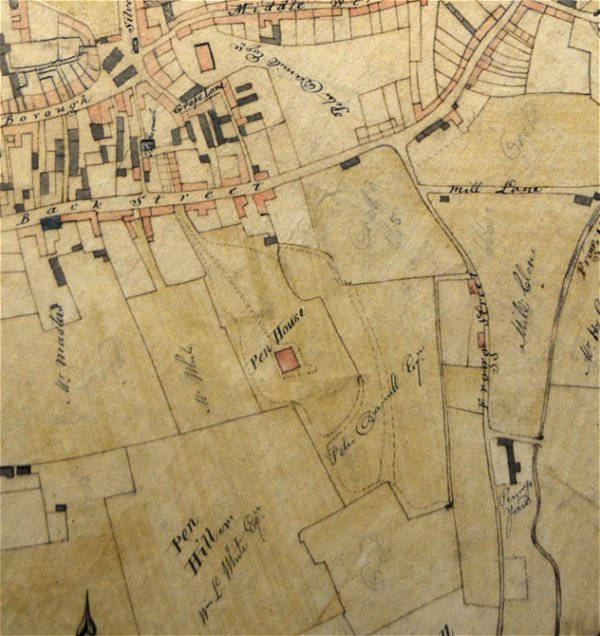
E Watts' map of 1806 clearly shows the extensive lands owned by Peter Daniell. At top centre (with his name written upside down) Peter Daniell's town centre land stretched from Middle Street down to Back Street (today's South Street) and across to where he would later build Union Street, Bond Street and Peter Street. At top left, immediately above the bend in Grope Lane (today's Wine Street), the red rectangle was the Middle Street mansion he inherited from his father. At centre is his home, Pen House, surrounded by the extensive grounds annotated with his name.
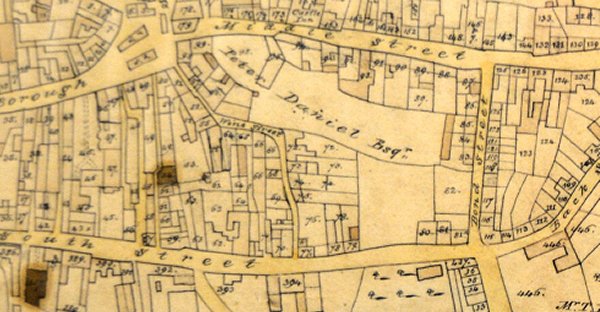
E Watts' map of 1831 showing Peter Daniell's town centre lands. By this time Bond Street had been built and buildings had been constructed both sides, but Union Street and Peter Street were yet to be built.
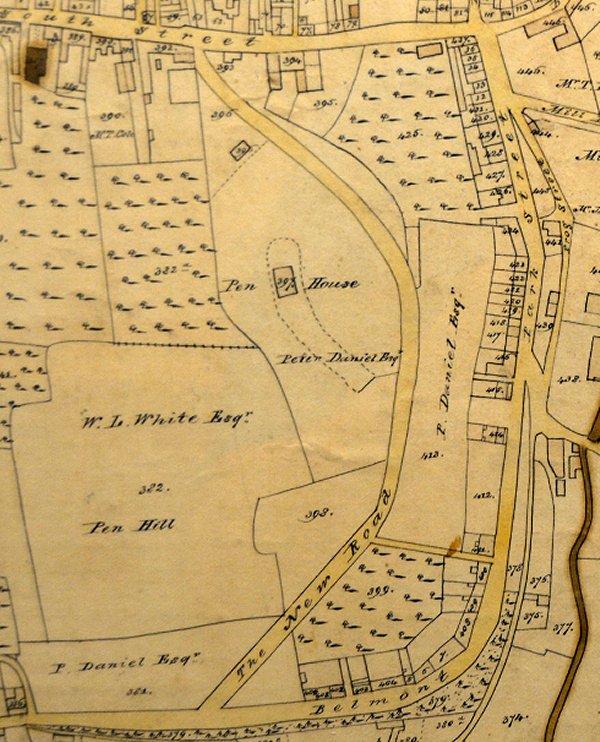
E Watts' map of 1831 showing Peter Daniell's Pen Hill estate. By this time he owned land stretching across Pen Hill from South Street to Belmont and he had built 'The New Road' (today's Penn Hill).as well as park Street and Belmont.
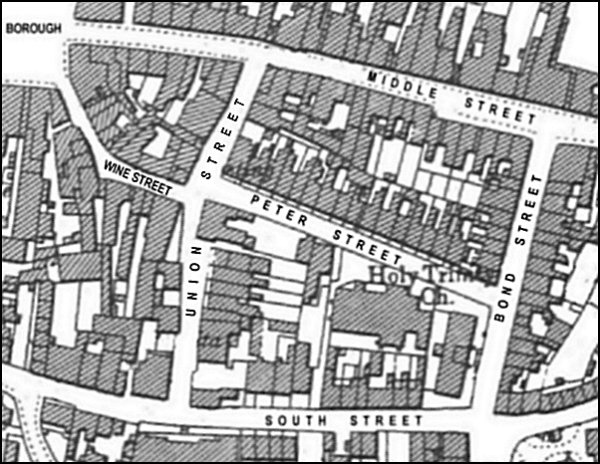
Map based on the 1901 Ordnance Survey. Union Street and Bond Street connected Middle Street with South Street with Peter Street connecting Union Street and Bond Street. All were built in the 1830's by Peter Daniell who named Peter Street after himself.
gallery
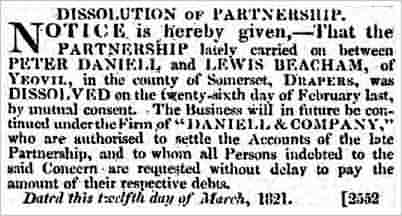
The notice of dissolution of the partnership between Peter Daniell and Lewis Beacham from the 19 March 1821 edition of the Salisbury & Winchester Journal.
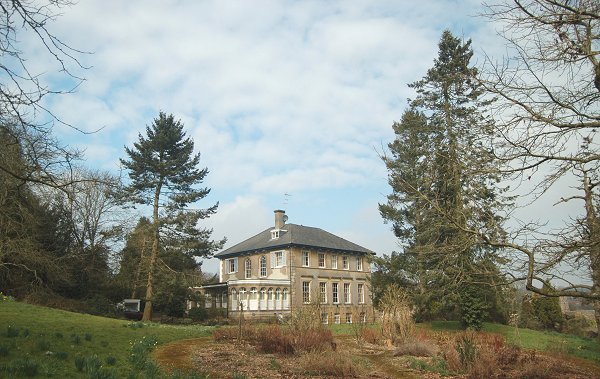
Penn House, the home of Peter Daniell, set in its still-extensive grounds. Seen from the southeast and photographed 2013.

From my
collection
Peter Daniell's signature on the 1832 Addlewell indenture.
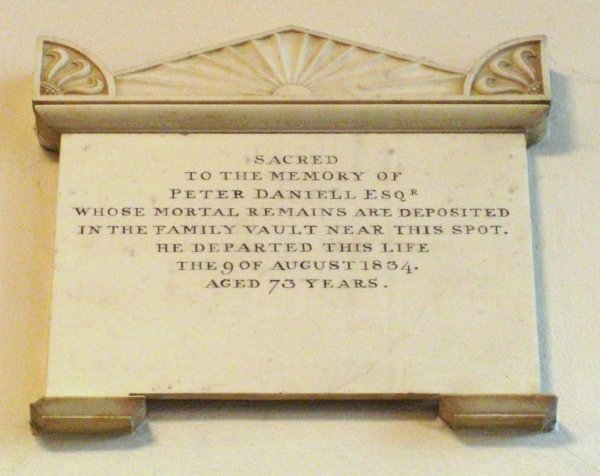
Memorial erected to the memory of Peter Daniell in St John's church.
The Will of Peter Daniell, 1828
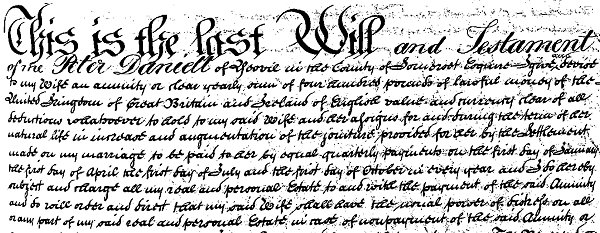
This is the last Will and Testament of me Peter Daniell of Yeovil in the County of Somerset Esquire - I give and devise to my Wife an annuity or clear yearly sum of four hundred pounds of lawful money of the United Kingdom of Great Britain and Ireland of English value and currency clear of all deductions whatsoever to hold to my said Wife and her assigns for and during the term of her natural life in interest and augmentation of the (illegible) provided for her by the Settlement made on my marriage to be paid to her by equal quarterly payments on the first day of January the first day of April the first day of July and the first day of October in every year and I do hereby subject and charge all my real and personal Estate to and with the payment of the said Annuity and do will order and desire that my said Will shall have the usual power of distress on all or any part of my said real and personal Estate in case of nonpayment of the said Annuity or any quarterly payment thereof I give devise and bequeath to my two sons The Reverend Henry Peter Daniell Clerk and Edward Hansford Daniell all and singular my Freehold & Leasehold Messuages Tenements Land Heredit[ament]s and Premises and all other my real and personal estate goods chattels and effects whatsoever and wheresoever to hold to them the said Henry Peter Daniell and Edward Hansford Daniell in equal shares and proportions as tenants in common and not as joint tenants and their respective heirs executors (illegible) and assigns according to the nature and (illegible) to and charged with the payment of the said annuity to my said Wife and I appoint my said sons joint Executors of this my last Will and Testament and do revoke all others by me at any time heretofore made In Witness whereof I have hereunto subscribed and set my hand and seal this twenty ninth day of January in the year of our Lord one thousand eight hundred and twenty eight -
Peter Daniell signed sealed published and declared by the said Testator Peter Daniell as and for his last Will and Testament in the presence of us who at his request and in his presence and in the presence of each other have hereunto subscribed our names as Witnesses - WL White - TS Orton - HS Sabine
Proved at London 26 Sept 1834 before the Judge by the Oaths of the Reverend Henry Peter Daniell Clerk and Edward Hansford Daniell Esquire the sons the Executors to whom Admin(istration) was granted having been first sworn by commission duly to administer.
Transcribed by Bob Osborn